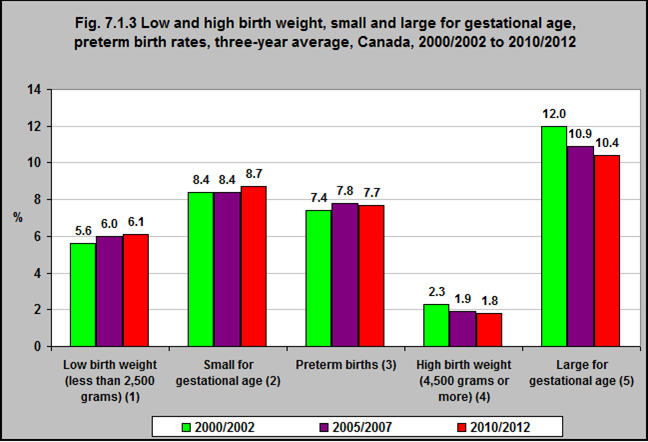Low and high birth weight, small and large for gestational age, preterm birth rates, three-year average, Canada, 2000/2002 to 2010/2012

Notes:
1) Live births with a birth weight less than 2,500 grams, expressed as a percentage of all live births (birth weight known).
2) Live births with a birth weight less than the 10th percentile of birth weights of the same sex and the same gestational age in weeks from Kramer et al. “A New and Improved Population-based Canadian Reference for Birth Weight for Gestational Age”. Expressed as a percentage of live singleton births with gestational ages from 22 to 43 weeks.
3) Live births with a gestational age less than 37 weeks expressed as a percentage of all live births (gestational age known).
4) Live births with a birth weight of 4,500 grams or more, expressed as a percentage of all live births (birth weight known).
5) Live births with a birth weight greater than the 90th percentile of birth weights of the same sex and the same gestational age in weeks from Kramer et al. “A New and Improved Population-based Canadian Reference for Birth Weight for Gestational Age”. Expressed as a percentage of live singleton births with gestational ages from 22 to 43 weeks.
Source: CICH graphic created using data adapted from Statistics Canada. Table 102-4318 – Birth-related indicators (low and high birth weight, small and large for gestational age, pre-term births), by sex, three-year average, Canada, provinces, territories, census metropolitan areas and metropolitan influence zones, occasional (number unless otherwise noted). http://www5.statcan.gc.ca/cansim/a26?lang=eng&retrLang=eng&id=1024318&&pattern=&stByVal=1&p1=1&p2=-1&tabMode=dataTable&csid=
– accessed June 24, 2017
Between 2000/02 and 2010/12, the low birth weight rate (less than 2,500 grams) increased in Canada from 5.6% to 6.1%.
The small for gestational age rate went from 8.4% to 8.7%, while the pre-term birth rate (before 37 weeks of gestation) went from 7.4% to 7.7%.
The large for gestational age rate declined from 12% to 10.4%.
Implications
Low birth weight is considered an important health indicator, because it is linked with many health problems across the life span.1 Babies who are born small for their gestational age are at increased risk of fetal and infant illness and death, and are more likely to be low birth weight.2 When babies are born at high birth weight or are large for their gestational age there can be complications for both the mother and baby – such as complicated birth and an increased risk of type-2 diabetes later in the child’s life.2
1March of Dimes. Low Birthweight. 2014. http://www.marchofdimes.org/complications/low-birthweight.aspx- accessed June 20, 2017.
2Public Health Agency of Canada. Canadian Perinatal Health Report: 2008 edition. Ottawa, ON: Public Health Agency of Canada. http://www.phac-aspc.gc.ca/publicat/2008/cphr-rspc/pdf/cphr-rspc08-eng.pdf – accessed June 20, 2017.
